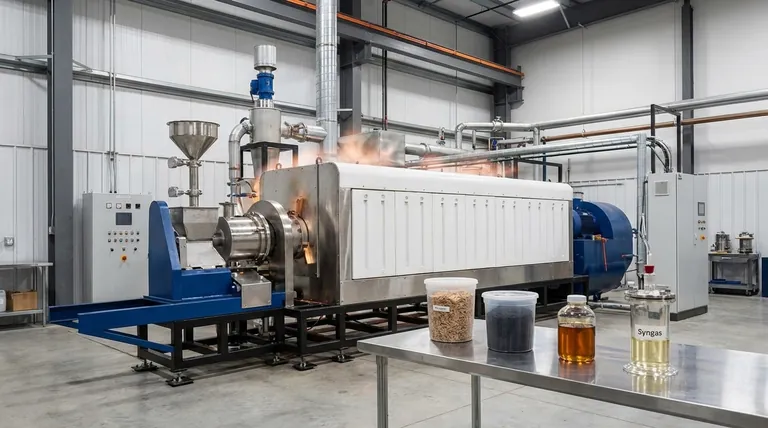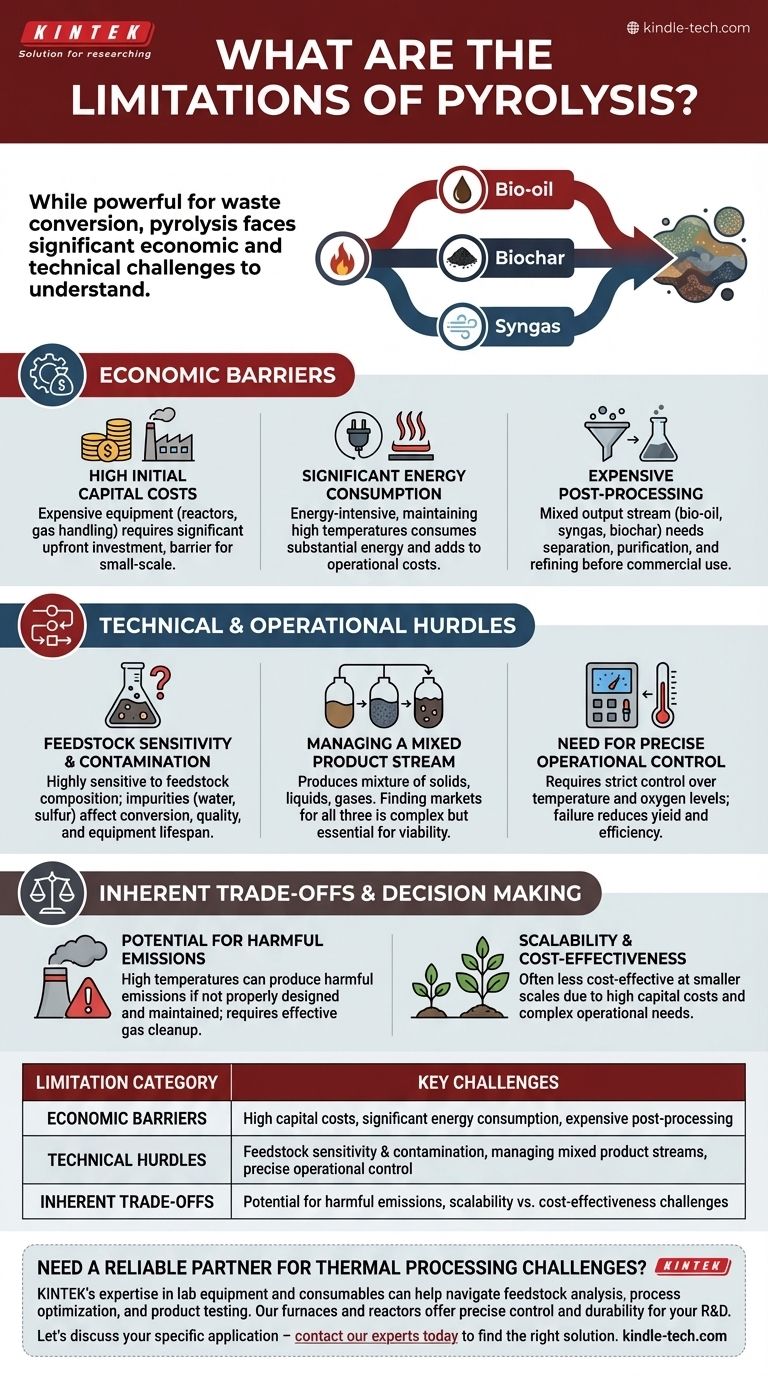While a powerful technology for waste conversion, pyrolysis faces significant limitations that are critical to understand. Its primary challenges are high capital and energy costs, the technical complexity of managing different feedstocks, and the need for extensive post-processing to purify its end products into commercially valuable materials.
The limitations of pyrolysis are not fundamental flaws in the science, but rather practical engineering and economic hurdles. Successfully implementing pyrolysis depends less on the core process itself and more on managing feedstock variability, controlling operational costs, and refining the mixed output.

The Economic Barriers to Widespread Adoption
The financial viability of a pyrolysis project is often the most significant challenge. These systems require careful economic modeling to ensure they are not just technically feasible but also profitable.
High Initial Capital Costs
The equipment required for a pyrolysis system—including the reactor, feeding mechanisms, and gas handling systems—is expensive. This high upfront investment can be a major barrier, particularly for smaller-scale applications.
Significant Energy Consumption
Pyrolysis is an energy-intensive process by nature. It requires maintaining very high temperatures for extended periods, which consumes a substantial amount of energy and adds to the operational costs.
The Hidden Costs of Post-Processing
The direct outputs of pyrolysis (bio-oil, syngas, and biochar) are rarely ready for immediate use. This mixed stream requires separation, purification, and often significant refining, which is both time-consuming and expensive.
For example, raw bio-oil must be upgraded before it can be used as a stable transportation fuel, adding another layer of cost and complexity.
Key Technical and Operational Hurdles
Beyond the economics, the day-to-day operation of a pyrolysis plant presents several technical challenges that demand expertise and precision.
Feedstock Sensitivity and Contamination
Pyrolysis performance is highly sensitive to the composition of the feedstock. Results from pyrolyzing a pure substance, like methane, are only partially applicable when pyrolyzing a more complex source like natural gas.
Impurities found in real-world feedstocks—such as water, sulfur compounds, or other hydrocarbons—can react under pyrolysis conditions. This affects conversion rates, product quality, and the lifespan of catalysts and equipment.
Managing a Mixed Product Stream
Unlike processes that yield a single product, pyrolysis creates a mixture of solids (biochar), liquids (bio-oil), and gases (syngas). Managing and finding markets for all three product streams is essential for economic viability but adds operational complexity.
The Need for Precise Operational Control
To be efficient and environmentally sound, a pyrolysis furnace requires proper design, operation, and maintenance. Failure to maintain precise control over temperature and oxygen levels can reduce yield and efficiency.
Understanding the Trade-offs
Evaluating pyrolysis requires a clear-eyed view of its inherent compromises. The benefits of waste conversion do not come without potential downsides that must be actively managed.
Potential for Harmful Emissions
While a closed-loop process, the high temperatures involved can produce harmful emissions if the system is not properly designed and maintained. Effective gas cleanup and combustion systems are essential to minimize air quality impact and ensure the process remains environmentally friendly.
Scalability and Cost-Effectiveness
Although pyrolysis can be performed at smaller scales and in remote locations, it often becomes less cost-effective as the size decreases. The high capital cost and complex operational needs can make small-scale projects economically challenging without subsidies or high-value end products.
Making an Informed Decision on Pyrolysis
To determine if pyrolysis is the right solution, you must align the technology's capabilities with your specific goal.
- If your primary focus is waste volume reduction: Pyrolysis is highly effective, but you must have a clear and budgeted plan for processing and selling the bio-oil, biochar, and syngas it produces.
- If your primary focus is producing high-grade transportation fuel: Be prepared for substantial investment in the downstream refining and purification infrastructure required to upgrade the raw bio-oil.
- If your primary focus is decentralized energy from biomass: The technology is viable, but success depends on securing a consistent, clean, and low-cost feedstock to offset the high operational costs.
Ultimately, viewing pyrolysis as a complete integrated system—from feedstock intake to final product sale—is the key to overcoming its limitations.
Summary Table:
| Limitation Category | Key Challenges |
|---|---|
| Economic Barriers | High capital costs, significant energy consumption, expensive post-processing |
| Technical Hurdles | Feedstock sensitivity & contamination, managing mixed product streams, precise operational control |
| Inherent Trade-offs | Potential for harmful emissions, scalability vs. cost-effectiveness challenges |
Need a reliable partner for your thermal processing challenges? While pyrolysis has its complexities, KINTEK's expertise in lab equipment and consumables can help you navigate feedstock analysis, process optimization, and product testing. Our furnaces and reactors are designed for precise control and durability, supporting your R&D and quality control efforts. Let's discuss your specific application – contact our experts today to find the right solution for your laboratory's needs.
Visual Guide

Related Products
- Electric Rotary Kiln Small Rotary Furnace Biomass Pyrolysis Plant
- Electric Rotary Kiln Pyrolysis Furnace Plant Machine Calciner Small Rotary Kiln Rotating Furnace
- Electric Rotary Kiln Continuous Working Small Rotary Furnace Heating Pyrolysis Plant
- Vacuum Sealed Continuous Working Rotary Tube Furnace Rotating Tube Furnace
- Mesh belt controlled atmosphere furnace
People Also Ask
- What are the reactions involved in pyrolysis of biomass? Unlock the Chemistry for Tailored Bio-Products
- What are the different types of pyrolysis machines? Choose the Right System for Your Output
- What are the products of pyrolysis of biomass? Unlock Bio-Char, Bio-Oil, and Syngas
- What are the conditions for biomass pyrolysis? Optimize Temperature, Heating Rate & Time
- What is a disadvantage of biomass energy? The Hidden Environmental and Economic Costs



















